St. George’s Mushroom
A great Spring mushroom that can usually be found several weeks either side of St. George’s day.
| Mushroom Type | |
| Common Names | St. George's Mushroom (EN), Pengrwm Calan Mai (CY), Gęśnica Wiosenna (PL), Májusi Pereszke (HU) |
| Scientific Name | Calocybe gambosa |
| Season Start | Apr |
| Season End | May |
| Average Mushroom height (CM) | 5-8 |
| Average Cap width (CM) | 6-10 |
Gills
Gills white/pale cream. Crowded and roughly the same height along their length until becoming much shallower before reaching the stem (emarginate). The gills are generally very shallow as can be seen in the ‘Flesh’ image below.
Habitat
Grasslands, beside woodland, lawns and roadsides growing in rings. It is relatively easy to find because it grows in grassy fields usually but not always near trees where, from a distance, you will often see the ring as the grass will be darker and longer there as shown in the adjacent photo.
Possible Confusion
The Deadly Fibrecap (Inosperma erubescens) appears at the end of Spring and early Summer and can look similar but it stains bright red and its cap is covered in fine fibres.
Taste / Smell
Good, mushroomy and loses its mealyness a lot when cooked, especially if cooked with a creamy sauce. Must be cooked before consumption.
Frequency
Common, very common some years.
Other Facts
An easy to identify mushroom with its mealy smell and the time of year it fruits.
The St. George’s mushroom can usually be found in the same place every year and seems to grow quite successfully when old mushrooms that are too maggoty for the pot have been carefully placed in the right environment.



 (67 votes, average: 3.60 out of 5)
(67 votes, average: 3.60 out of 5)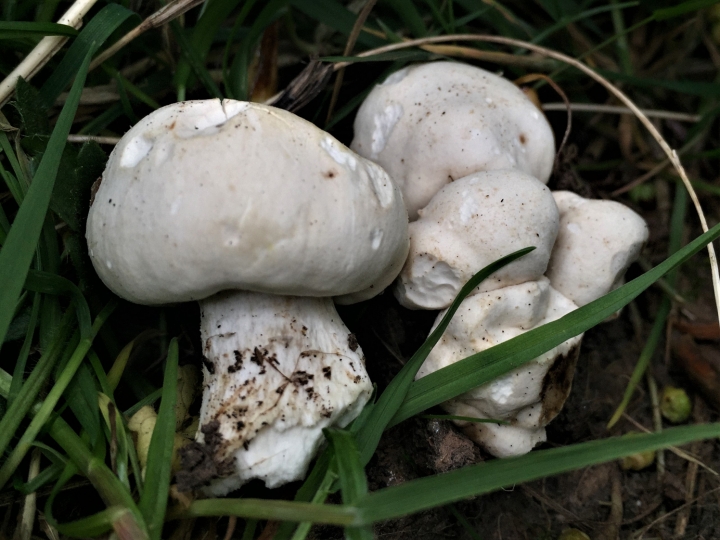















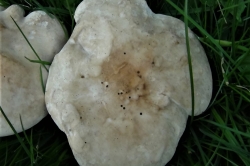
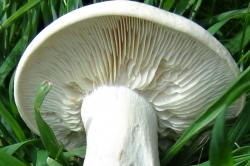
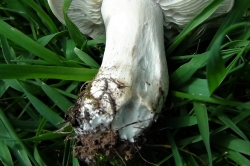
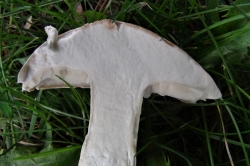
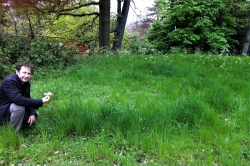
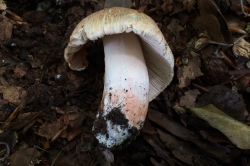







25 comments for St. George’s Mushroom
Is it better to look for st George’s mushroom after a warm rain only not seeing them in the usual places at the moment. Thanks
ANDY
Mushrooms are very fussy and want exactly the right conditions to appear. Most mushrooms prefer wet or damp and not too hot weather.
We had 3 days rain and weather was warm , and I found some cracking st George mushrooms as big as my hand
I found some st. George’s mushrooms yesterday when I went for a bike ride, they were growing on the road side and It was impossible to not see them from distance (half ring), a bit late for their season and very mature, big specimens but still a good find. To be on the safe side I did a spore print and yes it was white.
I believe i may have found st george mushroom today jan 5th sorry George 😅
You may be right but I would be very surprised to see any this early.
I’m in Kent and yet to find these anyone in Kent had any luck
As it happens, yes, today! I have a little spot that I discovered last year and there has been nothing there for the last couple of weeks I’ve been spot-checking, then today, dozens of them! Still a bit small yet, but by the 23rd, I reckon they’ll be perfect. Still nabbed a bowlful of the largest ones though!
Just found a beautiful ring today on a morning wander! I was so delighted! We also found three exquisite yellow morels at the weekend! Oh golly were we overjoyed by this find! We are a family of four – our two young children aged 5 and 7 are more knowledgeable than I am! Anyway, I have saved my pickings for them to enjoy with us after school – St George’s mushrooms on toast me thinks. YUM!
Hi, just found a ring of these outside my house. I’m sure they are St George’s mushrooms but could do with a bit of reassurance. I did the foraging course a few years ago but I’ve not seen these with the white gills before. Any help would be appreciated.
… can’t seem to attach the photos for some reason??
Send photos to [email protected].
Just been to my local Essex airfield where there must be 50 or so packed rings of these. Same place I get my Macros from, which also luckily for me have zero maggots!
Found some growing in same spot as three weeks ago in the grass at the side of a ploughed field, left some for the mice. Toast and mushrooms for tomorrow’s breakfast.
hi – novice forager here. I usually eat these from my garden. Have a lovely one today but the gill shape seems different, maybe because it’s large? There is a bulge around the stem, about 1 to 1.5 inches out. Also it’s late in the season but then this year has been very cold here in the Midlands. Is there any chance it isn’t a St George’s (it’s near where mine usually grow). I’ll do a spore print anyway but that means it’s not quite fresh to eat 🙂
Sorry for the late reply, it won’t be fresh now. Without seeing it I couldn’t be sure but my best ID for St Georges is a stout stem, growing in a ring, shallow gills unless quite old and a distinctive smell which people describe differently but the most common are; sawdust, paper or watermelon. There are still a few about now and any left are quite large.
It’s 11 April and I’ve already found an abundant fairy ring of St George’s mushrooms in SE London. It’s not even been particularly rainy or humid and the last few days the temperature went almost sub zero last week. I guess there will be loads of these in a few weeks’ time, but this gorgeous bunch will do for now. I left plenty behind as it really was more than enough. If I hadn’t known how they look and where they grow I’d have easily dismissed them as not worthwhile. Funny how they change from an enticing mealy/watermelon smell to slighly odd plasticine once you bring them home, but that’s exactly how it’s supposed to be. It’s a first for me but if I like them I guess I’ll be coming back for more.
Found some of these lovely mushrooms today in my mothers garden just as described in the long grass and by trees. I first for me but unmistakable.
Hi I found them today in rings but I would like to send you some photos to help me with the identification. All the specifications are matching.
Hi Eric, can these grow amongst the trees with barely any grass around? There are lots of nettles but I found these amongst a slight clearing in the nettles. It’s right next to a field and in the same spot as I found some field blewits during the winter. It fits all of the above ID points and smells like wet flour to me.
They prefer growing in grass but I do find them in grassless woodland, sometimes on bare soil and yesterday among nettles in a wooded area. As long as the mushroom doesn’t bruise almost blood red where touched or damaged, it can’t really be anything else at this time of year. The smell is the best ID, if you can remember the smell, you’ll always ID St Georges correctly.
Found many St. George’s mushrooms by a path in short grass in three big circles in Surrey parkland. Took enough for breakfast at the same time leaving plenty for others to view
Found some the other day in a churchyard, gonna go back for more tomorrow cos’ they were AMAZING!
Found a big group of them today while walking Witches’ trail! Delighted to make them with wild garlic, yum!
I cooked in butter, but they were very watery. I strained away the water, then cooked in more butter. Please advise on best way to cook and season.
The best way for me is to cook them is in butter until the ‘water’ has evaporated, season and add cream and smoked oil.